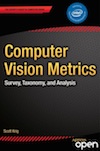In this edition of Embedded Vision Insights:
- New Demo and Tutorial Videos
- Vision-Based Gesture Interfaces
- Free Online Book: Computer Vision Metrics
- Embedded Vision in the News
| LETTER FROM THE EDITOR |
|
I'm delighted to tell you about three new videos published to the Alliance website. Basler begins with a tutorial on industrial camera interfaces; the different kinds and most common options available, followed by a practical design example. Synopsys focuses on ADAS; its video from the 2015 Embedded Vision Summit demonstrates a speed sign detection algorithm running on a FPGA-housed version of the company's neural-network-focused vision processor core. And speaking of FPGAs, Xilinx demonstrates in its Embedded Vision Summit video the company's new high-level SDSoC development environment, applicable to both Zynq-7000 and newest Zynq UltraScale CPU+FPGA chips. There’s also plenty of new written content on the Alliance website. "Increasing Performance and Power Efficiency in Heterogeneous Software," the latest in a series of articles from Imagination Technologies, describes a typical use case for heterogeneous computing and the challenges (and their solutions) that result from moving to a heterogeneous programming model. Shorter writeups come from Auviz Systems, with a trip report on a recent Boston Image Processing Computer Vision Group meeting covering deep learning, and from Synopsys, on optimizing DSPs for vision-based automotive applications. And don't forget to also check out the market analysis and press release sections of the website, which contain several new entries. Finally, speaking of the Embedded Vision Summit, I'd like to remind you of next year's event, taking place from May 2-4, 2016 in Santa Clara, California. Now in its fourth year, the inspiring and practical Embedded Vision Summit will focus exclusively on bringing visual intelligence to your products, whether embedded, wearable, cloud-based or mobile. New breakthroughs. New technology. New insights. And expanded offerings across the program. It’s an event you won’t want to miss. Mark your calendar and keep an eye on the website and this newsletter for more information to come shortly. Thanks as always for your support of the Embedded Vision Alliance, and for your interest in and contributions to embedded vision technologies, products and applications. If you have an idea as to how the Alliance can better service your needs, please contact me. Brian Dipert |
| FEATURED VIDEOS |
|
"Vision-Based Gesture User Interfaces," a Presentation from Qualcomm
VectorBlox Demonstration of Various Vision Algorithms
|
| FEATURED ARTICLES |
|
Computer Vision Metrics: Survey, Taxonomy, and Analysis
Intruder Alarm Equipment: Where’s the Growth?
|
| FEATURED NEWS |
|
Xilinx Showcases Industry’s First 16nm All Programmable MPSoC at ARM TechCon 2015 TI Strengthens ADAS Portfolio with the Introduction of Latest Processor in TDA Family ON Semiconductor Announces Sampling of Next Generation Automotive Image Sensor with LED Flicker Mitigation and ASIL B Support Qualcomm Signs Definitive Agreement to Sell Vuforia Business to PTC VATICS Chooses CEVA Imaging and Vision DSP for its Surveillance and Smart Camera SoCs
|







